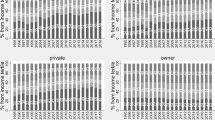Abstract
There is ample evidence that imprisonment deteriorates the income and housing situation of former prisoners. Little is known about the degree to which income and housing of (former) prisoners deteriorates during imprisonment. The objective of this article is to give a more detailed description of the changing income situation and housing situation during imprisonment by describing income and housing of (former) prisoners directly before and directly after imprisonment. To this end we make use of data on the entire population of prisoners who were released from Dutch prisons during the second half of 2008. Our results show that prisoners are characterised by a considerably problematic profile with regard to income and housing both before and after imprisonment. The income and housing situation of prisoners is worse directly after imprisonment than directly before imprisonment.
Similar content being viewed by others
Notes
In total, this involves 32.2 % of all prisoners who have completed their sentence.
In this research we consider shelter as having an accommodation, although in the US shelter stays are sometimes used as an indicator of homelessness. We do so, because in Dutch aftercare policy shelter is considered as a type of accommodation, because their aim is to get prisoners off the streets.
References
Adamczuk, H. (2007). Meeting the housing needs of prisoners and ex-offenders in the UK: Opportunities and limitations. Birmingham: University of Central England.
Andrews, D. A., & Bonta, J. (2006). The psychology of criminal conduct (4th ed.). Newark: Lexis/Nexis.
Baldry, E., McDonnell, D., Maplesston, P., & Peeters, M. (2003). Ex-prisoners and accomodation: What bearing do different forms of housing have on social reintegration? Melbourne: AHURI.
Baldry, E., McDonnell, D., Maplesston, P., & Peeters, M. (2006). Ex-prisoners, homelessness and the State in Australia. The Australian and New Zealand Journal of Criminology, 39(1), 20–33.
Blokland, A., & Nieuwbeerta, P. (2005). The effects of life circumstances on longitudinal trajectories of offending. Criminology, 43(4), 1203–1240.
Blom, M., Oudhof, J., Bijl, R. V., & Bakker, B. F. M. (2005). Verdacht van Criminaliteit: Allochtonen en Autochtonen Nader Bekeken. Den Haag: WODC/CBS.
Carlisle, J. (1996). The housing needs of ex-prisoners. Yourk: Joseph Rowntree foundation.
Cheliotis, L. K. (2009). Before the next storm: Some evidence-based reminders about temporary release. International Journal of Offender Therapy and Comparative Criminology, 53(4), 420–432.
DJI. (2008). Annual Report 2007: Safely working towards change. Den Haag: DJI.
DJI (2012). Overzicht erkende penitentiaire programma’s van 1 April 2011 – 1 April 2012. Available online at: http://www.dji.nl/Onderwerpen/Volwassenen-in-detentie/Straffen-en-maatregelen/.
Geller, A., & Curtis, M. A. (2011). A sort of homecoming: incarceration and the housing security of urban men. Social Science Research, 40, 1196–1213.
Geller, A., Garfinkel, I., & Western, B. (2006). The Effects of Incarceration on Employment and Wages – An Analysis of the Fragile Families Survey. Available online at: http://www.saferfoundation.org/files/documents/Princeton-Effect%20of%20Incarceration%20on%20Employment%20and%20Wages.pdf.
Gendreau, P., Smith, P., & French, S. A. (2006). The theory of effective correctional intervention: empirical status and future directions. In F. T. Cullen, J. P. Wright, & K. R. Blevins (Eds.), Taking stock: The status of criminological theory (pp. 419–446). New Brunswick: Transaction.
ISt (Inspectorate for the Implementation of Sanctions). (2008). Aansluiting nazorg in het gevangeniswezen. Den Haag: ISt.
Laub, J. H., & Sampson, R. J. (2001). Understanding desistance from crime. In M. Tonry (Ed.), Crime and justice: A review of research (Vol. 28, pp. 1–69). Chicago, IL/London: The University of Chicago Press.
Laub, J. H., & Sampson, R. J. (2003). Shared beginnings, divergent lives: Delinquent boys to age 70. Cambridge: Harvard University Press.
Lipsey, M. W., & Cullen, F. T. (2007). The effectiveness of correctional rehabilitation: a review of systematic reviews. Annual Review of Law and Social Science, 3, 297–320.
Maguire, M., Hutson, S., & Nolan, J. (2007). Accomodation for ex-prisoners in the south west region. Pontypridd: University of Glamorgan.
Maruna, S. (2001). Making good: How ex-convicts reform and rebuild their lives. Washington, DC: American Psychological Association.
McCarthy, B., & Hagan, J. (1991). Homelessness: a criminogenic situation? British Journal of Criminology, 31(4), 393–410.
Metraux, S., & Culhane, D. P. (2004). Homeless shelter use and reincarceration following prison release. Criminology & Public Policy, 3(2), 139–160.
Niven, S., & Olangundoye, J. (2002). Jobs and Homes: A Survey of Prisoners near Release. Home Office Findings 173.
Pettit, B., & Lyons, C. J. (2009). Incarceration and the legitimate labor market: examining age-graded effects on employment and wages. Law & Society Review, 43(4), 725–756.
Roman, C. G., & Travis, J. (2006). Where will I sleep tomorrow? Housing, homelessness, and the returning prisoner. Housing Policy Debate, 17(2), 389–418.
Sampson, R. J., & Laub, J. H. (1993). Crime in the making: Pathways and turning points through life. Cambridge: Harvard University Press.
Skardhamar, T., & Telle, K. (2012). Post-release employment and recidivism in Norway. Journal of Quantitative Criminology, 28(4), 629–649.
Tripodi, S. J., Kim, J. S., & Bender, K. (2010). Is employment associated with reduced recidivism? The complex relationship between employment and crime. International Journal of Offender Therapy and Comparative Criminology, 54(5), 706–720.
Uggen, C. (2000). Work as a turning point in the life course of criminals: a duration model of age, employment, and recidivism. American Sociological Review, 67, 529–546.
Venkatesh, S. A. (2006). Off the books: The underground economy of the urban poor. Cambridge: Harvard University Press.
Warr, M. (1998). Life-course transitions and desistance from crime. Criminology, 36(2), 183–216.
Wartna, B. S. J., et al. (2009). Recidivism Report 1997–2006: Development in the reconviction rate of Dutch offenders. Den Haag: WODC.
Western, B., Kling, J. R., & Weiman, D. F. (2001). The labor market consequences of incarceration. Crime & Delinquency, 47(3), 410–427.
Author information
Authors and Affiliations
Corresponding author
Appendix 1
Appendix 1
Rights and permissions
About this article
Cite this article
Weijters, G., More, A. Comparing Income and Housing of Former Prisoners After Imprisonment with their Situation Before Imprisonment. Eur J Crim Policy Res 21, 35–48 (2015). https://doi.org/10.1007/s10610-013-9225-3
Published:
Issue Date:
DOI: https://doi.org/10.1007/s10610-013-9225-3




